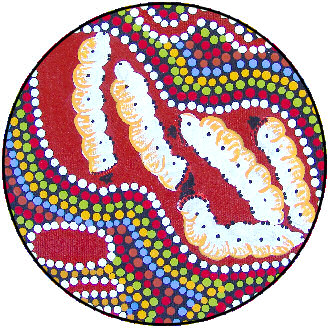Aboriginal Symbols of Fauna and Wildlife
| WARNING: Aboriginal and Torres Strait Islander people are warned that this website contain images, voices and names of people who have passed away. |
Indigenous Symbols, Iconography and Imagery
- Aboriginal Symbols
———————————— - Man Woman Child
- Human Activity
- Tools & Weapons
———————————— - Bush Food
- Bush Medicine
- Wildlife
- Emu
- Goanna
- Honey Ant
- Kangaroo
- Thorny Devil
- Witchetty Grub
————————————
- Landscape & Country
- Rain & Water
————————————
One of the popular imagery of bush tucker include the iconic Witchetty Grub, that is enjoyed eaten both raw and cooked. It is also used in traditional medicine by the aboriginal people.
In their depiction of the witchetty grub, many artist stamp their own unique way of portraying the grub, whether it is a close facsimile of the insect, a unique clustering arrangement or a modern take that may emphasise a particular pattern.

Witchetty Grub Information
Witchetty bush is one of the important plant for the Indigenous People of Australia, especially because of the large tasty grub found in the roots of the plant, where it makes its home. The grub is the larvae of a large grey moth (goat moth / cossid moth) that can grow up to 6 cm and longer. During a really good season, you can collect up to as many as 50 grubs from the roots of one decent size bush.

The grubs are rich in proteins and fats that are easily assimilated by humans, and as a food source is highly valued by the Aborigines. Although the grubs can be found at all times of the year, not all Witchetty bushes will harbour the grub. The moths themselves are also eaten.1


Like the honey ants, the witchetty grubs are depicted in bush tucker artworks, often in the same paintings. Sometimes in the same paintings the artists would include the symbol imagery of the digging sticks, coolamon, women and occasionally children. The meticulous works of Audrey Rubuntja and her daughter Clarabelle Swift, often depict the witchetty grubs in their bush tucker paintings. Other Aboriginal artists including Janet Forrester Ngala and Janet Long Nakamarra have produced a number of works on the ‘Witchetty Grub Dreaming’.
For more information check out the Witchetty Grub (Endoxyla leucomochla).
- Scientific classification
- Kingdom: Animalia
- Phylum: Arthropoda
- Class: Hexapoda
- Order: Lepidoptera
- Family: Cossidae
- Genus: Endoxyla
- Species: E. leucomochla
- Common name: Witchetty grub
- Arrernte name: Atnyematye, tyape
- Luritja name: maku
Footnote & References
- Peter Latz, Bushfires and Bushtucker Aboriginal Plant Use in Central Australia, IAD Press, Alice Springs, 2004, p103-104
- Witchetty grubs by Trephina Sultan (top feature image)
